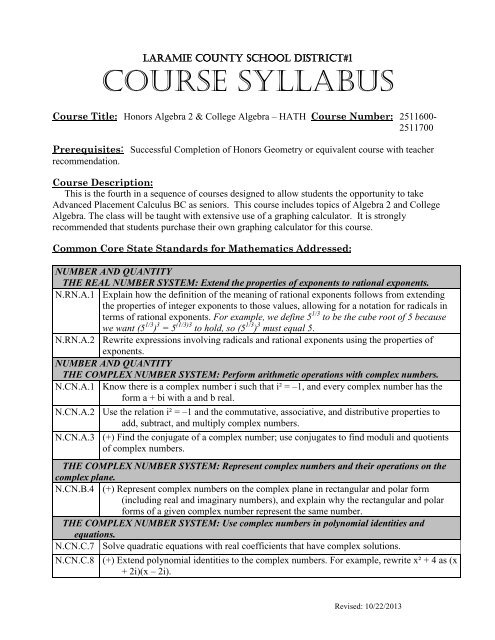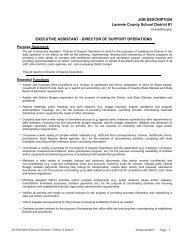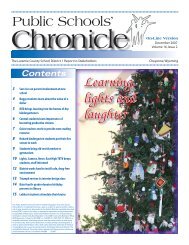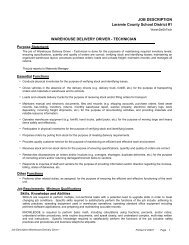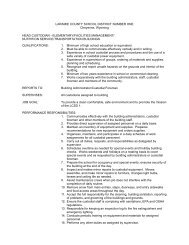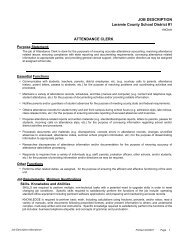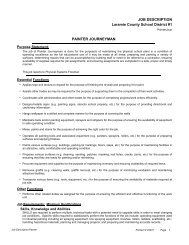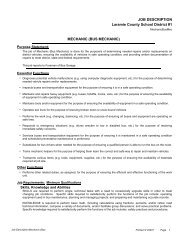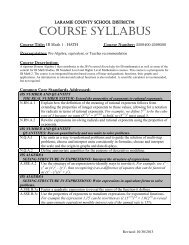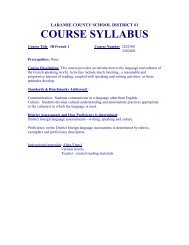Honors Algebra 2 & College Algebra - Central High School
Honors Algebra 2 & College Algebra - Central High School
Honors Algebra 2 & College Algebra - Central High School
You also want an ePaper? Increase the reach of your titles
YUMPU automatically turns print PDFs into web optimized ePapers that Google loves.
Laramie County <strong>School</strong> District#1<br />
Course Syllabus<br />
Course Title: <strong>Honors</strong> <strong>Algebra</strong> 2 & <strong>College</strong> <strong>Algebra</strong> – HATH Course Number: 2511600-<br />
2511700<br />
Prerequisites: Successful Completion of <strong>Honors</strong> Geometry or equivalent course with teacher<br />
recommendation.<br />
Course Description:<br />
This is the fourth in a sequence of courses designed to allow students the opportunity to take<br />
Advanced Placement Calculus BC as seniors. This course includes topics of <strong>Algebra</strong> 2 and <strong>College</strong><br />
<strong>Algebra</strong>. The class will be taught with extensive use of a graphing calculator. It is strongly<br />
recommended that students purchase their own graphing calculator for this course.<br />
Common Core State Standards for Mathematics Addressed:<br />
NUMBER AND QUANTITY<br />
THE REAL NUMBER SYSTEM: Extend the properties of exponents to rational exponents.<br />
N.RN.A.1 Explain how the definition of the meaning of rational exponents follows from extending<br />
the properties of integer exponents to those values, allowing for a notation for radicals in<br />
terms of rational exponents. For example, we define 5 1/3 to be the cube root of 5 because<br />
we want (5 1/3 ) 3 = 5 (1/3)3 to hold, so (5 1/3 ) 3 must equal 5.<br />
N.RN.A.2 Rewrite expressions involving radicals and rational exponents using the properties of<br />
exponents.<br />
NUMBER AND QUANTITY<br />
THE COMPLEX NUMBER SYSTEM: Perform arithmetic operations with complex numbers.<br />
N.CN.A.1 Know there is a complex number i such that i² = –1, and every complex number has the<br />
form a + bi with a and b real.<br />
N.CN.A.2 Use the relation i² = –1 and the commutative, associative, and distributive properties to<br />
add, subtract, and multiply complex numbers.<br />
N.CN.A.3 (+) Find the conjugate of a complex number; use conjugates to find moduli and quotients<br />
of complex numbers.<br />
THE COMPLEX NUMBER SYSTEM: Represent complex numbers and their operations on the<br />
complex plane.<br />
N.CN.B.4 (+) Represent complex numbers on the complex plane in rectangular and polar form<br />
(including real and imaginary numbers), and explain why the rectangular and polar<br />
forms of a given complex number represent the same number.<br />
THE COMPLEX NUMBER SYSTEM: Use complex numbers in polynomial identities and<br />
equations.<br />
N.CN.C.7 Solve quadratic equations with real coefficients that have complex solutions.<br />
N.CN.C.8 (+) Extend polynomial identities to the complex numbers. For example, rewrite x² + 4 as (x<br />
+ 2i)(x – 2i).<br />
Revised: 10/22/2013
N.CN.C.9 (+) Know the Fundamental Theorem of <strong>Algebra</strong>; show that it is true for quadratic<br />
polynomials.<br />
ALGEBRA<br />
SEEING STRUCTURE IN EXPRESSIONS: Interpret the structure of expressions.<br />
A.SSE.A.1a Interpret parts of an expression, such as terms, factors, and coefficients.<br />
A.SSE.A.2 Use the structure of an expression to identify ways to rewrite it. For example, see x 4 – y 4<br />
as (x 2 ) 2 – (y 2 ) 2 , thus recognizing it as a difference of squares that can be factored as<br />
(x 2 – y 2 )(x 2 + y 2 ).<br />
ALGEBRA<br />
SEEING STRUCTURE IN EXPRESSIONS: Write expressions in equivalent forms to solve<br />
problems.<br />
A.SSE.B.3a Factor a quadratic expression to reveal the zeros of the function it defines.<br />
A.SSE.B.3b Complete the square in a quadratic expression to reveal the maximum or minimum value<br />
of the function it defines.<br />
A.SSE.B.3c Use the properties of exponents to transform expressions for exponential functions. For<br />
example the expression 1.15 t can be rewritten as (1.15 1/12 ) 12t ≈ 1.012 12t to reveal the<br />
approximate equivalent monthly interest rate if the annual rate is 15%.<br />
A.SSE.B.4 Derive the formula for the sum of a finite geometric series (when the common ratio is not<br />
1), and use the formula to solve problems. For example, calculate mortgage<br />
payments. ★<br />
ALGEBRA<br />
ARITHMETIC WITH POLYNOMIALS & RATIONAL FUNCTIONS: Perform arithmetic<br />
operations on polynomials.<br />
A.APR.A.1 Understand that polynomials form a system analogous to the integers, namely, they are<br />
closed under the operations of addition, subtraction, and multiplication; add,<br />
subtract, and multiply polynomials.<br />
ARITHMETIC WITH POLYNOMIALS & RATIONAL FUNCTIONS: Understand the<br />
relationship between zeros and factors of polynomials.<br />
A.APR.B.2<br />
A.APR.B.3<br />
Know and apply the Remainder Theorem: For a polynomial p(x) and a number a, the<br />
remainder on division by x – a is p(a), so p(a) = 0 if and only if (x – a) is a factor of<br />
p(x).<br />
Identify zeros of polynomials when suitable factorizations are available, and use the<br />
zeros to construct a rough graph of the function defined by the polynomial.<br />
ALGEBRA<br />
ARITHMETIC WITH POLYNOMIALS & RATIONAL EXPRESSIONS: Use polynomial identities<br />
to solve problems.<br />
A.APR.C.4<br />
A.APR.C.5<br />
Prove polynomial identities and use them to describe numerical relationships. For<br />
example, the polynomial identity (x 2 + y 2 ) 2 = (x 2 – y 2 ) 2 + (2xy) 2 can be used to<br />
generate Pythagorean triples.<br />
(+) Know and apply the Binomial Theorem for the expansion of (x + y) n in powers of x<br />
and y for a positive integer n, where x and y are any numbers, with coefficients<br />
determined for example by Pascal’s Triangle.<br />
Revised: 10/22/2013
ARITHMETIC WITH POLYNOMIALS & RATIONAL FUNCTIONS: Rewrite rational<br />
expressions.<br />
A.APR.D.6 Rewrite simple rational expressions in different forms; write a(x) / b(x) in the form q(x)<br />
+ r(x) / b(x) , where a(x), b(x), q(x), and r(x) are polynomials with the degree of r(x) less<br />
than the degree of b(x), using inspection, long division, or, for the more complicated<br />
examples, a computer algebra system.<br />
A.APR.D.7 (+) Understand that rational expressions form a system analogous to the rational<br />
numbers, closed under addition, subtraction, multiplication, and division by a<br />
nonzero rational expression; add, subtract, multiply, and divide rational expressions.<br />
ALGEBRA<br />
REASONING WITH EQUATIONS & INEQUALITIES: Understand solving equations as a<br />
process of reasoning and explain the reasoning.<br />
A.REI.A.1 Explain each step in solving a simple equation as following from the equality of numbers<br />
asserted at the previous step, starting from the assumption that the original equation has a<br />
solution. Construct a viable argument to justify a solution method.<br />
A.REI.A.2 Solve simple rational and radical equations in one variable, and give examples showing<br />
how extraneous solutions may arise.<br />
REASONING WITH EQUATIONS & INEQUALITIES: Solve equations and inequalities in one<br />
variable.<br />
A.REI.B.3 Solve linear equations and inequalities in one variable, including equations with<br />
coefficients represented by letters.<br />
A.REI.B.4a Use the method of completing the square to transform any quadratic equation in x into<br />
an equation of the form (x – p)² = q that has the same solutions. Derive the quadratic<br />
formula from this form.<br />
A.REI.B.4b Solve quadratic equations by inspection (e.g., for x² = 49), taking square roots,<br />
completing the square, the quadratic formula and factoring, as appropriate to the initial<br />
form of the equation. Recognize when the quadratic formula gives complex solutions<br />
and write them as a ± bi for real numbers a and b.<br />
REASONING WITH EQUATIONS & INEQUALITIES: Solve systems of equations.<br />
A.REI.C.5 Prove that, given a system of two equations in two variables, replacing one equation by<br />
the sum of that equation and a multiple of the other produces a system with the same<br />
solutions.<br />
A.REI.C.7 Solve a simple system consisting of a linear equation and a quadratic equation in two<br />
variables algebraically and graphically. For example, find the points of intersection<br />
between the line y = –3x and the circle x² + y² = 3.<br />
REASONING WITH EQUATIONS & INEQUALITIES: Represent and solve equations and<br />
inequalities graphically.<br />
A.REI.D.11<br />
Explain why the x-coordinates of the points where the graphs of the equations y = f(x)<br />
and y = g(x) intersect are the solutions of the equation f(x) = g(x); find the solutions<br />
approximately, e.g., using technology to graph the functions, make tables of values, or<br />
find successive approximations. Include cases where f(x) and/or g(x) are linear,<br />
polynomial, rational, absolute value, exponential, and logarithmic functions. ★<br />
Revised: 10/22/2013
ALGEBRA<br />
CREATING EQUATIONS: Create equations that describe numbers or relationships.<br />
A.CED.A.1 Create equations and inequalities in one variable and use them to solve problems.<br />
Include equations arising from linear and quadratic functions, and simple rational and<br />
exponential functions.<br />
A.CED.A.2 Create equations in two or more variables to represent relationships between quantities;<br />
graph equations on coordinate axes with labels and scales.<br />
A.CED.A.3 Represent constraints by equations or inequalities, and by systems of equations and/or<br />
inequalities, and interpret solutions as viable or nonviable options in a modeling context.<br />
For example, represent inequalities describing nutritional and cost constraints on<br />
combinations of different foods.<br />
A.CED.A.4 Rearrange formulas to highlight a quantity of interest, using the same reasoning as in<br />
solving equations. For example, rearrange Ohm’s law V = IR to highlight resistance R.<br />
FUNCTIONS<br />
INTERPRETING FUNCTIONS: Interpret functions that arise in applications in terms of the<br />
context.<br />
F.IF.B.4<br />
For a function that models a relationship between two quantities, interpret key features<br />
of graphs and tables in terms of the quantities, and sketch graphs showing key features<br />
given a verbal description of the relationship. Key features include: intercepts; intervals<br />
where the function is increasing, decreasing, positive, or negative; relative maximums<br />
and minimums; symmetries; end behavior; and periodicity. ★<br />
F.IF.B.5 Relate the domain of a function to its graph and, where applicable, to the quantitative<br />
relationship it describes. For example, if the function h(n) gives the number of personhours<br />
it takes to assemble n engines in a factory, then the positive integers would be an<br />
appropriate domain for the function. ★<br />
FUNCTIONS<br />
INTERPRETING FUNCTIONS: Analyze functions using different representations.<br />
F.IF.C.7a Graph linear and quadratic functions and show intercepts, maxima, and minima.<br />
F.IF.C.7b<br />
F.IF.C.7c<br />
F.IF.C.7d<br />
F.IF.C.7e<br />
F.IF.C.8a<br />
F.IF.C.8b<br />
F.IF.C.9<br />
Graph square root, cube root, and piecewise-defined functions, including step functions<br />
and absolute value functions.<br />
Graph polynomial functions, identifying zeros when suitable factorizations are<br />
available, and showing end behavior.<br />
(+) Graph rational functions, identifying zeros and asymptotes when suitable<br />
factorizations are available, and showing end behavior.<br />
Graph exponential and logarithmic functions, showing intercepts and end behavior, and<br />
trigonometric functions, showing period, midline, and amplitude.<br />
Use the process of factoring and completing the square in a quadratic function to show<br />
zeros, extreme values, and symmetry of the graph, and interpret these in terms of a<br />
context.<br />
Use the properties of exponents to interpret expressions for exponential functions. For<br />
example, identify percent rate of change in functions such as y = (1.02)t, y = (0.97)t, y =<br />
(1.01)12t, y = (1.2)t/10, and classify them as representing exponential growth or decay.<br />
Compare properties of two functions each represented in a different way (algebraically,<br />
graphically, numerically in tables, or by verbal descriptions). For example, given a<br />
graph of one quadratic function and an algebraic expression for another, say which has<br />
the larger maximum.<br />
Revised: 10/22/2013
FUNCTIONS<br />
BUILDING FUNCTIONS: Build a function that models a relationship between two quantities.<br />
F.BF.A.1 Write a function that describes a relationship between two quantities. ★<br />
F.BF.A.1b Combine standard function types using arithmetic operations. For example, build a<br />
function that models the temperature of a cooling body by adding a constant function to<br />
a decaying exponential, and relate these functions to the model.<br />
F.BF.A.1c (+) Compose functions. For example, if T(y) is the temperature in the atmosphere as a<br />
function of height, and h(t) is the height of a weather balloon as a function of time, then<br />
T(h(t)) is the temperature at the location of the weather balloon as a function of time.<br />
FUNCTIONS<br />
BUILDING FUNCTIONS: Build new functions from existing functions.<br />
F.BF.B.3 Identify the effect on the graph of replacing f(x) by f(x) + k, k f(x), f(kx), and f(x + k) for<br />
specific values of k (both positive and negative); find the value of k given the graphs.<br />
Experiment with cases and illustrate an explanation of the effects on the graph using<br />
technology. Include recognizing even and odd functions from their graphs and algebraic<br />
expressions for them.<br />
F.BF.B.4 Find inverse functions.<br />
F.BF.B.5 (+) Understand the inverse relationship between exponents and logarithms and use this<br />
relationship to solve problems involving logarithms and exponents.<br />
FUNCTIONS<br />
LINEAR, QUADRATIC, AND EXPONENTIAL MODELS: Construct and compare linear and<br />
exponential models and solve problems.<br />
F.LE.A.1 Distinguish between situations that can be modeled with linear functions and with<br />
exponential functions.<br />
F.LE.A.1c Recognize situations in which a quantity grows or decays by a constant percent rate per<br />
F.LE.A.4<br />
unit interval relative to another.<br />
For exponential models, express as a logarithm the solution to ab ct = d where a, c, and d<br />
are numbers and the base b is 2, 10, or e; evaluate the logarithm using technology.<br />
GEOMETRY<br />
EXPRESSING GEOMETRIC PROPERTIES WITH EQUATIONS: Translate between the<br />
geometric description and the equation for a conic section.<br />
G.GPE.A.2 Derive the equation of a parabola given a focus and directrix.<br />
(+) Denotes a fourth year math standard.<br />
★ Denotes a modeling standard.<br />
District Assessments:<br />
Standards are assessed by common quarterly district exams given to <strong>Honors</strong> <strong>Algebra</strong> 2<br />
& <strong>College</strong> <strong>Algebra</strong> students. These assessments will be 30% of the student’s course<br />
grade.<br />
Revised: 10/22/2013
Graduation Requirements:<br />
Beginning with the class of 2015, students must complete 4 credits of math in order to<br />
graduate from high school. Students must also be proficient in 5 content areas in<br />
order to graduate from high school, one of which could be math. Proficiency in a course<br />
will be earned if a student earns a 70% or better for both semesters of the course.<br />
Hathaway Scholarship:<br />
This course is one of the three math courses that must be completed for the success<br />
curriculum in the Hathaway Scholarship, as it represents an equivalent to the <strong>Algebra</strong><br />
2 course. Four years of math are required in the <strong>Honors</strong>, Performance, and<br />
Opportunity levels of the scholarship. Those four years consist of <strong>Algebra</strong> 1,<br />
Geometry, <strong>Algebra</strong> 2, and a fourth course.<br />
Course Organization:<br />
Semester 1<br />
Number Systems & Inequalities<br />
Parent Functions & Transformations<br />
Quadratics<br />
Factoring<br />
Adopted Instructional Materials:<br />
Semester 2<br />
Composition/Inverses/Exponentials<br />
Logarithms & Exponentials<br />
Polynomials<br />
Rational & Irrational <strong>Algebra</strong>ic<br />
Functions<br />
Larson, R., & Falvo, D. C. (2011). <strong>Algebra</strong> and Trigonometry, Eighth Edition.<br />
Brooks/Cole, Cengage Learning.<br />
Revised: 10/22/2013


